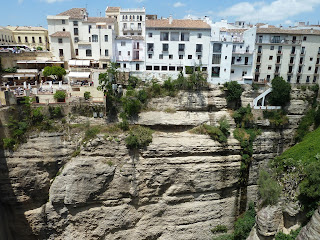On the way from Granada to Seville we detoured along the Costa del Sol to see the sights. This coast line has many summer resorts varying in exclusivity from "all comers" to "rich & famous only". We stopped at the Torremolinos resort and paddled in the Mediterranean. It's a nice beach and there are plenty of people waiting to bring you an expensive cocktail, but in my (humble) opinion any number of NZ beaches are just as good or better even if you have to walk over the sand hills and carry your own chilly bin. It was very early season so not many people around. The ones on the beach were mostly past their posing prime.
 |
| No, Sue, it's not me. |
 |
| During my paddle I was nearly knocked over by a big wave - NOT. |
 |
| Ronda's new bridge. |
 |
| The new town at Ronda. |
 |
| The many steps down the mine shaft provided a much needed workout for the knees. |
At Seville we are staying at the Hotel las Casas de la Juderia. This is an experience in itself. It consists of a number of centuries old houses linked together into a 134 room hotel. Back in the day the area was part of the Jewish ghetto, hence the name of the hotel. It is very easy to get lost even walking between the reception and your room. Everywhere there are little corridors, patios, courtyards, stairways, even underground tunnels, linking the parts of the complex. Very little is in a straight line or on the same level. On top there is a roof garden with pool, bar, loungers etc. For research purposes we spent an hour and a half at the pool enjoying the 30 degree warm afternon and sampling a strawberry Mojito. (Preliminary research finding: the regular Mojitos are better).
Seville was once a super important city for trade (through the river port) with the gold from Spanish South America coming there. Now it seems to rely more on tourism and just being a great place to live. One gets the impression that the main activity for many people is to stroll in the evenings and socialise - not that this is a bad thing and it certainly makes for a pleasant holiday experience!
The city has several landmark buildings including the Seville cathedral which is the 3rd largest in the world after St Peter's in the Vatican and St Paul's in London. Like the Mesquita in Cordoba it was once a Mosque, but consecrated as a cathedral after the Spanish catholic monarchs expelled the Moors in the 13th century. The mosque courtyard and minaret have been incorporated into the massive Gothic cathedral. Christopher Columbus's tomb is inside. Whether all, or any part, of him is actually in the tomb remains in dispute.
.
Seville also has an Alcazar (royal palace from Moorish days), and the spectacular pavilions from the 1929 world fair. The Spanish pavilion is massive. It took 14 years to build, for a 1 year fair, and has been a tourist attraction ever since.
 |
| Spanish pavilion |
We cruised around the above landmarks and then wandered in the streets of the old city. This is pretty much a guarantee of getting lost, which we did, but in a good way as there is always something interesting around the corner.
 |
| Downtown Seville - Santa Cruz quarter. |
On Saturday evening we went to a Flamenco show which was a pretty amazing experience. Our last one (30 years ago) was quite underwhelming so we're pleased we tried again. Tomorrow we get a 45 minute Flamenco lesson. Will see how that goes, most likely will only put us further in awe of the performers! Hopefully won't be any castanet or hand clapping injuries.











































